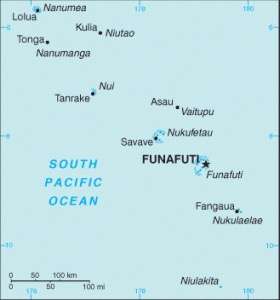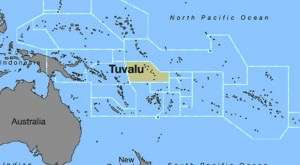Jeff Fleischer
- 2008

Fellowship Title:
- The Evacuation of Tuvalu
Fellowship Year:
- 2008

Adapting on the Atoll
(Alicia Patterson Reporter, Spring 2009) Tuvalu Map FUNAFUTI, TUVALU – Karl Tili joined the Tuvalu Philatelic Bureau in 1976, when the former Ellice Islands colony first began to produce its own stamps in the early years of self-government leading up to independence. He got to see firsthand how the stamp industry quickly established itself as one of Tuvalu’s leading sources of revenue and employment in the late 1970s and early 1980s, producing limited supplies of collectible issues for enthusiasts in some 60 countries. Before a decline in the mid-1980s, the bureau boasted dozens of employees and took up two buildings just southwest of the capital’s village center on Funafuti atoll. The bureau’s one-floor blue building now houses just a handful of workers, while most of its sales come from standing-order accounts overseas or sales to the country’s rare visitors. Now the bureau’s general manager, Tili is hoping to change that by creating a second heyday for Tuvalu stamps. In September, he accompanied the country’s finance minister on a trip to China, where he marketed his
Trying Out a New Country Before Climate Requires They Move
In a Strange Land August, 2008 – BAY OF PLENTY, New Zealand – Of all the adjustments she’s had to make since arriving in New Zealand, Annabelle Lolo Palota says one of the biggest struggles has been getting acclimatized to the climate. It’s no small change. In her homeland, the South Pacific atoll nation Tuvalu, temperatures rarely dip below the upper 80s. In the New Zealand winter, though, it routinely gets 30 to 40 degrees colder than that. On a winter day, she wears multiple layers of sweats and fights back sniffles and coughs brought on by one of several colds she’s acquired since arriving here. “The first time I ever saw the frost was when we were working down near Hastings,” she says. “All the Tuvalu people were outside our window going, ‘Wow, this is ice. It’s just like opening a refrigerator.’ We could see the tops of the mountains, so white. We were all wanting to actually go over there and stand on the ice, but we didn’t get a chance.” Palota

Against the Rising Tide
(Alicia Patterson Reporter, Summer 2008) WELLINGTON, New Zealand — On October 1, 1975, the British colony of the Gilbert and Ellice Islands officially split in two, with the nine small coral atolls of the Ellice Islands reclaiming their traditional name of Tuvalu. Exactly three years later, a new flag rose over the capital of Funafuti, with the Union Jack relegated to the upper left-hand corner and the rest a light blue field featuring nine yellow stars arranged in the shape of the new nation. The ceremonies that night included fireworks, champagne, a show of traditional dance, and salutes fired from American, British and Australian ships there for just that purpose. That night, after more than 80 years under the crown, Tuvalu began its life as an independent nation. Tuvalu’s birth was a model of self-determination, made possible when 92 percent of the islands’ mostly Polynesian citizens backed a referendum to separate from the mostly Micronesian Gilberts (which became independent Kiribati in 1980). At the time of independence, Tuvalu had no telephones, no television, and only
